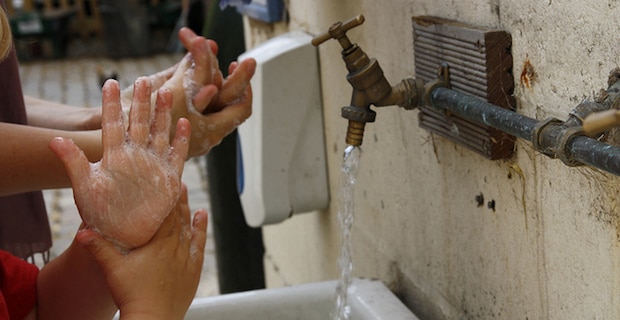
The spread of germs leads to a number of health issues for children, adults and seniors. Knowing how to reduce the risk is more than half the battle. Children in particular, learn new tasks surprisingly easy especially when the instruction consists of these three components:
- Tell the child what they are going to do (wash their hands) and explain the reason.
- Show the child how to wash their hands.
- Have the child practice the procedure to ensure the child is performing the task properly.
Read more about antibacterial soaps
According to the CDC, children can reduce the incidence of getting sick by 50 percent just by performing proper hand-washing during the following activities:
- Before eating or touching food
- After toileting
- After blowing their nose
- After coughing or sneezing in their hands
Read more about the 5 germiest surfaces
In the School Setting
Local health departments are bringing the hand-washing message to the schools. It is up to the school officials, teachers, and classroom aides to encourage and monitor proper hand-washing practices in the schools.
But-are the schools really getting the message?
I recently visited a number of schools in my area and found that during school hours, the bathrooms were seriously lacking in daily care. Many of the garbage cans were overflowing and the soap and paper towel dispensers were empty. It seems that janitorial services are not available during the day but are performed after school.
It is difficult to instruct students on personal hygiene when the school bathrooms fail to reflect cleanliness. I would suggest parents visit their child’s school during the day and check on the status of the bathrooms. A discussion with school officials might be enough to implement a cleaning schedule during school hours to reduce the spread of germs.
Talk About It & Model it
At school, teachers should be responsible for the practice of good hygiene skills. Children learn by both instruction and modeling behavior.
However, a word of caution: children learn a great deal from merely observing adults. If a child observes the teacher contradicting the behavior (bathroom etiquette) then the child is less likely to conform to the expected behavior.
Read more about the effect of chemicals on children's health
In conclusion, the most important thing to do to reduce the spread of germs is to practice good hygiene skills. Help children practice good hygiene by:
- Talking about it
- Showing it
- Practicing it
This will not only reduce the incidence of contracting an illness at school, but will also pave the road for a healthier life.
Image: magnusfranklin




